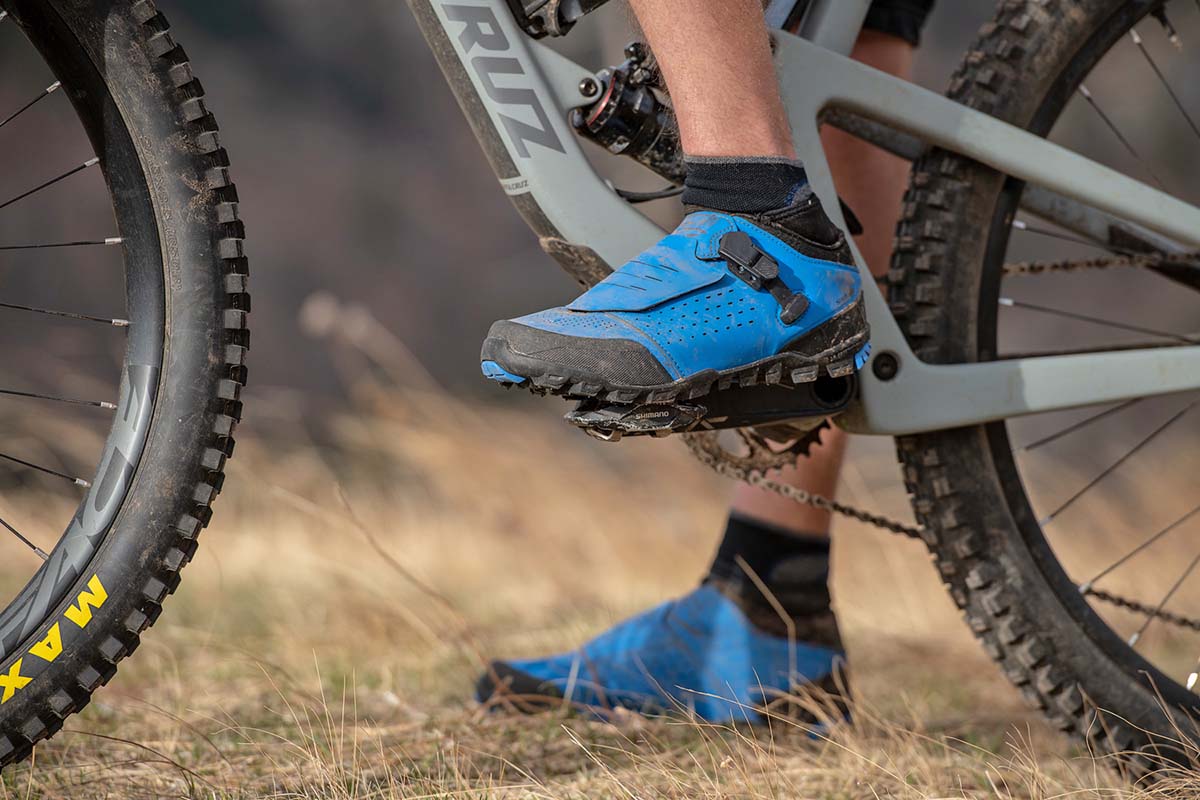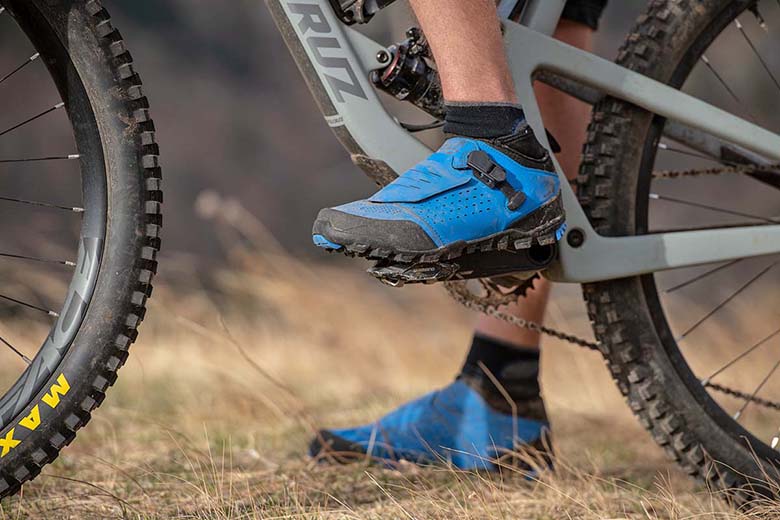

Switchback Travel (Jason Hummel)
Shimano has made a strong push in the mountain bike shoe world of late, releasing a number of quality and functional designs for clipless and flat pedal riders. Updated for 2019, the ME7 stands at the top of their enduro and trail line-up as a versatile, do-it-all shoe. I spent the past three months putting the clipless ME7 through its paces and have enjoyed its grippy Michelin outsole, quick lacing system, and on-bike performance. That said, I’ve also experienced some comfort-related issues with the neoprene cuff. Below I break down the Shimano ME7’s comfort, on-bike stability and support, off-bike traction, fit and sizing, and more. To see how it stacks up to the competition, see our article on the best mountain bike shoes.
The Shimano ME7 is the brand’s premium do-everything model, and its design and comfort reflect this. There’s decent cushioning underfoot that provides solid shock absorption for long and technical descents, the semi-stiff construction transfers power effectively without compromising performance on hike-a-bike sections, and the perforated upper material does an impressive job of keeping you cool. One thing that immediately stood out when trying on the shoe for the first time, however, was its wide toe box. Coming from the snug Giro Terraduro, I had some concerns about my feet sliding around, but this hasn’t been the case. Overall, those that prefer a performance-oriented fit (like myself) may find the ME7 lacking in this department, but it should be a great match for those that want a high-volume interior..jpg)
One notable area of concern that I have with the ME7 is its high collar and polarizing neoprene cuff. When I first slipped on the shoe, I immediately noticed something poking into the inside of both ankles where the neoprene meets the shoe. I’m used to a low-collared model like the Giro Terraduro, so I attributed this slight discomfort to the fact that the ME7 is one of the few over-the-ankle models I’ve worn in a while. However, another tester reported the same (albeit less intense) issue. It seems that while the tall collar provides solid protection against dirt and small rocks, the transition between fabrics could be smoother. The good news is that after a handful of rides, the irritation mostly subsided. But it strikes me that there’s an opportunity for Shimano to re-work the spot where the two fabrics meet. .jpg)
As a clipless all-mountain shoe that can handle rough, enduro-style trails, it’s no surprise that Shimano’s ME7 offers great on-bike support. The shoe’s recently added TORBAL (torsional balance) midsole allows more natural sideways flex in the back of the sole while the forefoot stays planted on the pedal, meaning better balance and bike control on techy descents. Further, the cleat attachment point on the ME7 is set farther back than on many other shoes, allowing riders to put more weight over the center (versus the ball) of the foot. Finally, the ME7 has a good amount of contact with the pedal, which adds to the overall connectedness between the bike and biker. All things considered, the new ME7 is one of the most confidence-inspiring shoes I’ve tested. In fact, I found the Shimano was noticeably more stable than my Giro Terraduro on technical terrain and while cruising downhill—a major compliment in my book. .jpg)
While its on-bike performance is undoubtedly impressive, the ME7’s off-bike traction truly sets it apart. Thanks to its tall lugs and soft rubber Michelin outsole, the ME7 has become my favorite hike-a-bike companion, especially on steep and loose terrain (and on wet logs, too). Even compared to the Vibram sole on my Terraduro, the Shimano ME7 is a much better performer (it also easily outperforms Specialized's 2FO Cliplite). As the trails in the Seattle area transformed from tacky fall singletrack into wintry muck throughout my testing, the Shimano continued to grip whatever I (and Mother Nature) threw at it..jpg)
For the ME7, Shimano chose a single-pull lacing system underneath a Velcro-secured nylon flap and an added buckle closure. Overall, I found this combination offers ample adjustment and customization options. I was especially impressed by the upper buckle’s low-profile design—any excess slack in the strap faces inward instead of out and remains hidden beneath the rest of the flap. I haven’t had any close calls with trail obstacles yet, but I imagine the streamlined buckle won’t snag or tear. The rest of the closure system is straightforward: simply pull the laces until your foot is snug—a task that’s easily performed with gloves on—and secure the nylon flap. However, I did find myself wishing there was more adjustability closer to the toe, and found that on-the-fly adjustments weren’t possible (a Boa dial system or ratchet design is a better option). But even with these drawbacks, the ME7’s closure system is still incredibly functional..jpg)
As I touched on above, I have mixed feelings about the shoe’s neoprene collar. On one hand, it’s adept at sealing out trail debris like rocks and dirt. On the other, I think it could have been better integrated into the overall construction to eliminate the inner-ankle irritation I felt where the cuff meets the shoe. Giro makes a tall-collared version of their Terraduro (the Terraduro Mid) that, in my opinion, more seamlessly meshes the two materials and is comfortable right out of the box. But all things considered, I’ve enjoyed the ME7’s added protection on many muddy days..jpg)
The ME7 tips the scale at 1 pound 11.9 ounces, which is relatively light considering its beefy outsole and full feature set. Looking at the competition, the ME7 undercuts Giro’s popular Terraduro (1 pound 13.6 ounces) but comes in slightly heavier than the Specialized 2FO ClipLite (1 pound 10.8 ounces). As far as the rest of the all-mountain market goes, most shoes fall in this narrow range. Cutting weight does reduce the amount of effort required to put the power down, but many bikers stick to shorter rides, and I appreciated the exceptional traction and added protection on the ME7. If you’re concerned about weight, cross-country shoes will be lighter and more streamlined. .jpg)
Shimano is well-known in the biking world for creating long-lasting, durable products, and the ME7 is no exception. Although the company opted for fairly lightweight materials in the build, the shoe has held up remarkably well throughout a fall and winter of relentless testing, including many days on muddy and sloppy trails. There are very minimal signs of wear on the sole (mostly where the pedal and shoe make contact), the nylon flap is in great shape, and the laces and buckles show no fraying or damage. At this point, I have no doubt the ME7 will live to see many more rides..jpg)
I generally prefer snug-fitting shoes—they connect me well to the pedals and make it easier to navigate technical downhills. However, despite choosing the correct size in the ME7 (I had to double-check, but I’m definitely a 42), I found the shoe was considerably more spacious than I’m used to. When placed next to my Giro Terraduro in the same size, it was immediately apparent that the ME7 has a much higher-volume shape to it. An insole could help eliminate some of the empty space, but those with narrow or low-volume feet might also want to consider other options..jpg)
.jpg)
| Shoe | Price | Category | Pedal | Weight | Closure |
|---|---|---|---|---|---|
| Shimano ME7 | $200 | All-mountain/XC | Clipless | 1 lb. 11.9 oz. | Ratchet, single-pull laces |
| $110 | All-mountain | Clipless | 1 lb. 13.6 oz. | Ratchet, Velcro | |
| Specialized 2FO Cliplite | $180 | All-mountain | Clipless | 1 lb. 10.8 oz. | Boa, Velcro |
| Giro Privateer R | $100 | XC/all-mountain | Clipless | 1 lb. 10.4 oz. | Ratchet, Velcro |
| Shimano ME5 | $160 | All-mountain/XC | Clipless | 1 lb. 11 oz. | Boa, Velcro |
My shoe of choice the past few seasons has been the Giro Terraduro, an all-mountain powerhouse that balances solid protection, a stiff build, and a grippy outsole. Stacked up against the Shimano ME7, I found the Shimano’s Michelin outsole had superior traction on the trail and the shoe’s tall collar did a better job of sealing out dirt (although the Terraduro comes in a “Mid” version, as well). However, when it comes to fit, I find the Terraduro is noticeably more snug, which helps maximize power transfer. It’s a tough call and might come down to personal preference, but at $90 cheaper, the Terraduro is a tough value to beat..jpg)
Another shoe to consider is the Specialized 2FO ClipLite. The ClipLite’s double BOA closure system and front Velcro strap have the edge when it comes to on-the-fly adjustments, and I prefer the less flashy styling over the techy-looking ME7. That said, the low-top ClipLite leaves your ankle more vulnerable, is a bit too rigid for hiking, and its SlipNot sole pales in comparison to the ME7’s Michelin outsole on soft ground. For $20 more, we think the ME7 is the better all-rounder..jpg)
The Privateer R is another great option from Giro. At $100 cheaper than the Shimano ME7, it’s an impressive value and offers decent performance. That said, the XC-oriented Privateer R does make some notable sacrifices: off-bike traction is subpar compared to the ME7 and its low collar and lack of cushioning doesn’t offer as much protection on rocky and root-filled trails. As in most cases, you get what you pay for, and we think the Shimano ME7 is worth it for the more aggressive riders and those that will appreciate the grippy outsole.
If you’re thinking about buying gear that we’ve reviewed on Switchback Travel, you can help support us in the process. Just click on any of the seller links above, and if you make a purchase, we receive a small percentage of the transaction. The cost of the product is the same to you but this helps us continue to test and write about outdoor gear. Thanks and we appreciate your support!
Depending on the seller, most products ship free in the United States on orders of $50 or more. International shipping availability and rates vary by seller. The pricing information on this page is updated hourly but we are not responsible for inaccuracies.